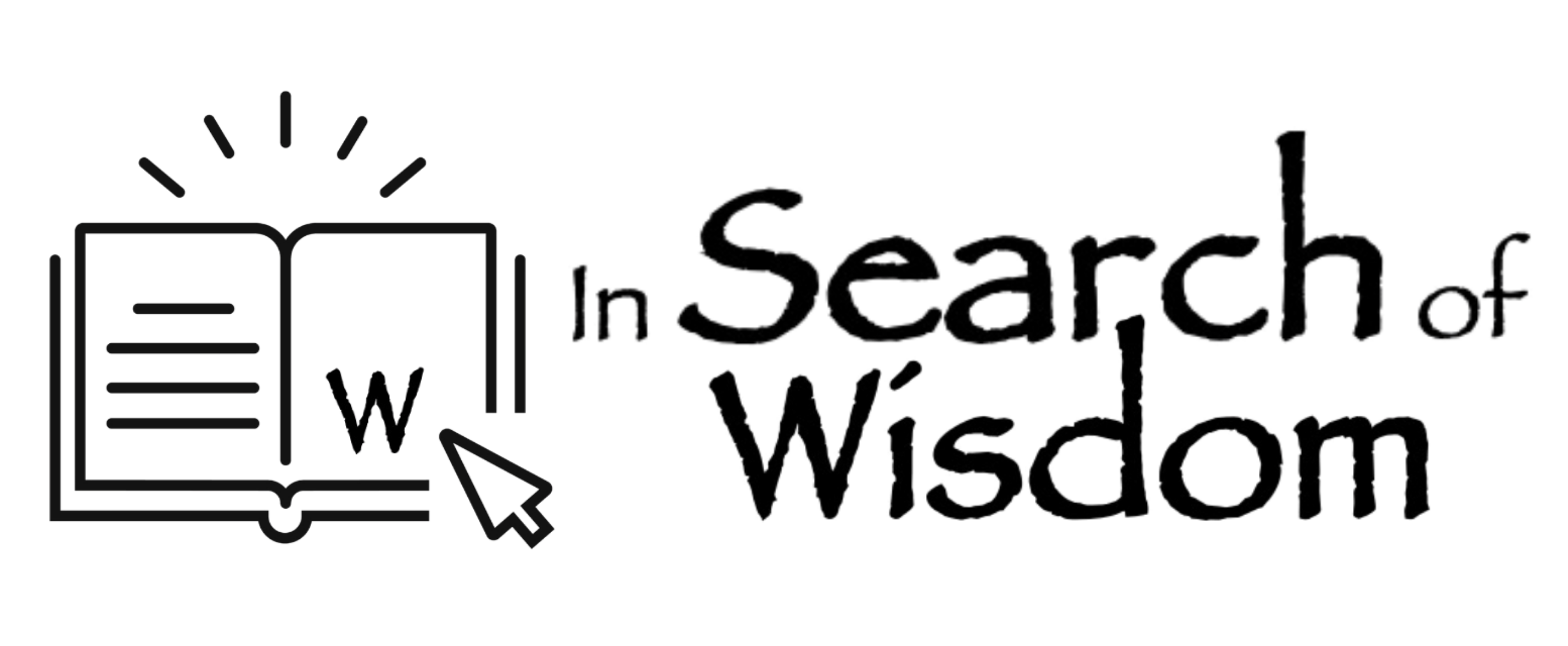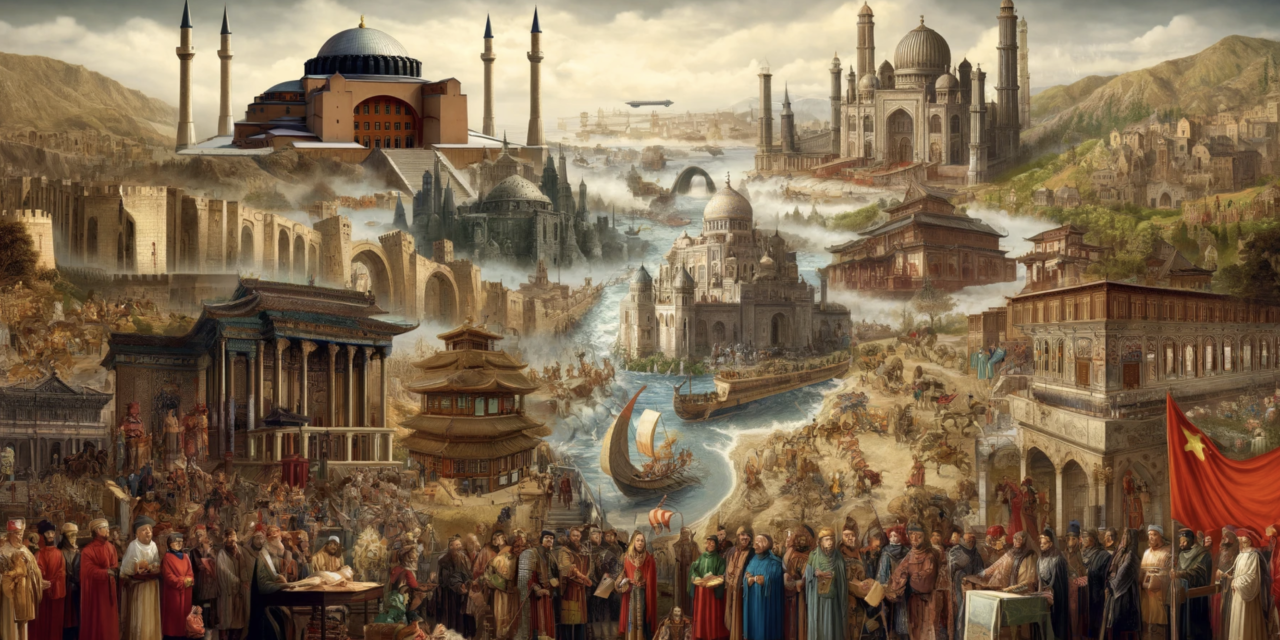Much of the history we were taught at school was Eurocentric, reinforcing our Western worldview and way of thinking. This brief review of the early Mediaeval period (roughly 500 AD to 1000 AD) looks at it differently: starting with the birth and flourishing of Islamic culture, turning to its Eastern contact with Tang China, its Western borders in Asia with Byzantium, and finally it’s struggle with Western Christendom.
Islam
Origins of Islam
Islam traces its origins to the life of Muhammad, who was born in Mecca around 570 CE. In 610 CE, Muhammad experienced a divine vision in which he believed God conveyed specific words for him to repeat. These words, which were memorable and poetic, included instructions for the people of Mecca to spread this message to non-believers. The basic tenets of Muhammad’s message emphasized righteous conduct, the rejection of false deities, submission to the one true God, and the importance of caring for the less fortunate.
Uniting the Arabs
Arab cities thrived through trade, with Mecca and Medina as notable centres. Medina, in particular, had a significant Jewish community, while Meccan traders who carried silk and spices to Byzantium were familiar with Christianity. Despite their fierce and warlike tribal customs, Muhammad’s poetic words and compelling message succeeded in uniting the disparate Arab tribes under his teachings. His strong leadership and the support of capable lieutenants like Abu Bakr and Umar, who trained the Bedouin in the art of war, were instrumental in this unification. The people of Medina welcomed Muhammad as a prophet who would bring peace among them, akin to how Alexander the Great united his empire.
Conquering Surrounding Lands
Following Muhammad’s death, Bedouin armies faced the formidable Byzantine and Persian empires. Utilizing camels to transport heavily armed troops, they launched strategic assaults akin to modern paratroop operations. The Muslim forces offered generous terms to key cities such as Damascus and Alexandria, promoting a “laissez-faire” approach to Islam. Under the Umayyad Caliphs, who were Bedouin Arabs, this period saw the collection of “protection money” and the siphoning of wealth. Grand mosques in Damascus and Jerusalem were constructed to rival the grandeur of Eastern Christian churches. However, the rapid expansion of Islam in the West was halted by the resilience of Byzantium and the strength of Eastern Christianity. This stalemate triggered revolts among Muslims in Khurasan and Mesopotamia.
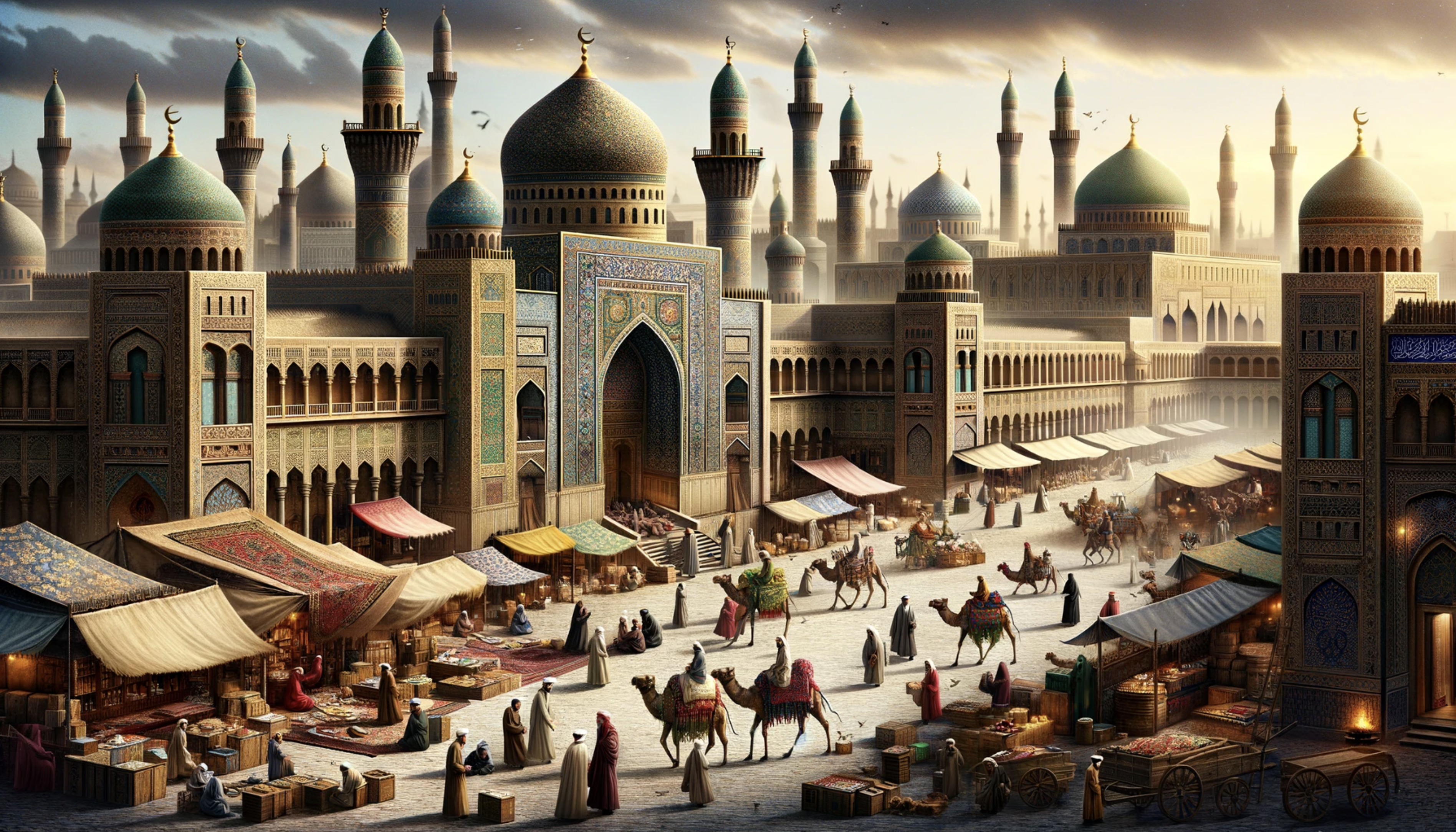
Consolidating Islamic Culture
The Abbasid Caliphs eventually replaced the Arab Umayyads, with Baghdad, founded in 762, becoming the new cultural and political centre. Baghdad’s House of Wisdom surpassed the renowned Library of Alexandria, highlighting the split between Sunnis and Shiites. Last year, we discussed Islamic science, emphasizing how Muslims valued all forms of knowledge. Arabic became the lingua franca of scholarship, facilitated by the “Translation Project” which integrated diverse scientific knowledge into Islamic culture. Trade by caravan across desert routes began to replace the traditional sea trade around the Mediterranean, shifting the focus and wealth towards the East.
Profiting from Slaves
Arab merchants played a significant role in the slave trade, operating both by land and sea. Slaves were transported across North Africa by land and to Baghdad and further East by sea. These slaves were crucial for domestic service, agriculture, and military purposes. Notably, the Mamluk soldiers, who were slaves, evolved into a formidable fighting force. In Africa, the Ghana Empire, which preceded the later Mali Empire, also engaged in extensive trade and the utilization of slave labour.
Tang China
Introduction
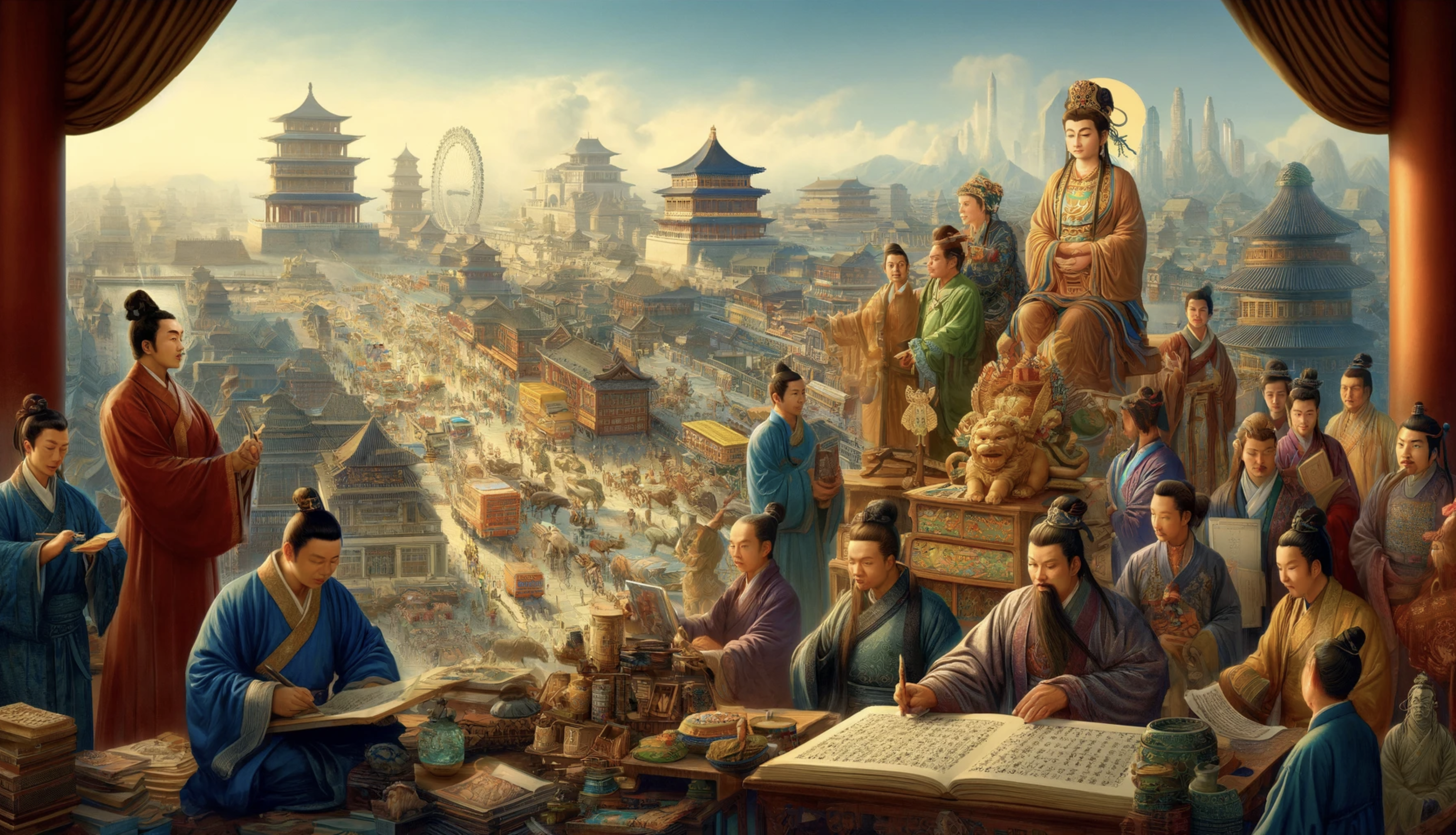
In the East, the expansion of Islam was effectively restrained by the formidable Tang Dynasty in China and the Gurjara-Pratiharas in Northern India. The Tang Dynasty, reigning from 618 to 907 CE, is widely regarded as a golden age of Chinese civilization. This period was marked by a highly centralized bureaucracy that operated on Confucian principles, epitomized by the “Three Departments and Six Ministries” structure. This system ensured efficient governance and administration throughout the empire.
A notable aspect of Tang governance was the Civil Service Examinations, which recruited scholar-officials based on merit rather than birth. This practice promoted a meritocratic bureaucracy. The Tang Dynasty also saw the reign of Wu Zhao, also known as Empress Wu, from 684 to 705 CE. She remains China’s only female emperor, and her rule is a testament to the dynasty’s dynamic and, at times, unorthodox nature.
Culture and Art
The Tang era is celebrated for its remarkable cultural and artistic achievements. This period is often referred to as the golden age of Chinese poetry and literature. Tang poets such as Li Bai and Du Fu produced works that remain influential to this day. In the realm of visual arts, Tang artists achieved new heights, especially in the creation of heroic sculptures of the Buddha and the development of new art styles, including innovative ceramics.
The capital city of Chang ‘an (modern-day Xi’an) was a bustling cosmopolitan metropolis, attracting people from diverse cultures and regions. The city served as a melting pot of ideas and traditions, enhancing the cultural richness of the Tang Dynasty. A common written language and shared philosophical outlook helped to integrate the vast Chinese state, fostering a sense of unity and cultural cohesion.
Shared Philosophy
Tang China was characterized by the harmonious coexistence and mutual complementarity of the “Three Teachings”: Confucianism, Daoism, and Buddhism. Each of these philosophies contributed to the moral and spiritual fabric of Chinese society.
The heroic travels of the monk XuanZang epitomize the period’s intellectual and spiritual pursuits. XuanZang journeyed to India to obtain original Buddhist texts, significantly contributing to the transmission and development of Buddhism in China. His efforts helped transform the Sanskrit term “dhyana” (meditation) into “Chan” in Chinese, which eventually evolved into “Zen” in Japanese Buddhism.
Science and Trade
The Tang Dynasty was also a period of significant scientific and technological innovation. One of the most notable inventions was woodblock printing, which revolutionized the dissemination of knowledge and literature. Furthermore, the Chinese shared the technique of papermaking with Muslims, which had a profound impact on the Islamic world and beyond.
Trade flourished under the Tang, particularly along the Silk Road, which facilitated the exchange of goods, ideas, and technologies between East and West. The era saw considerable advancements in various fields, including medicine, astronomy, and agriculture, contributing to the overall prosperity and sophistication of Tang society.
Byzantium
General Situation
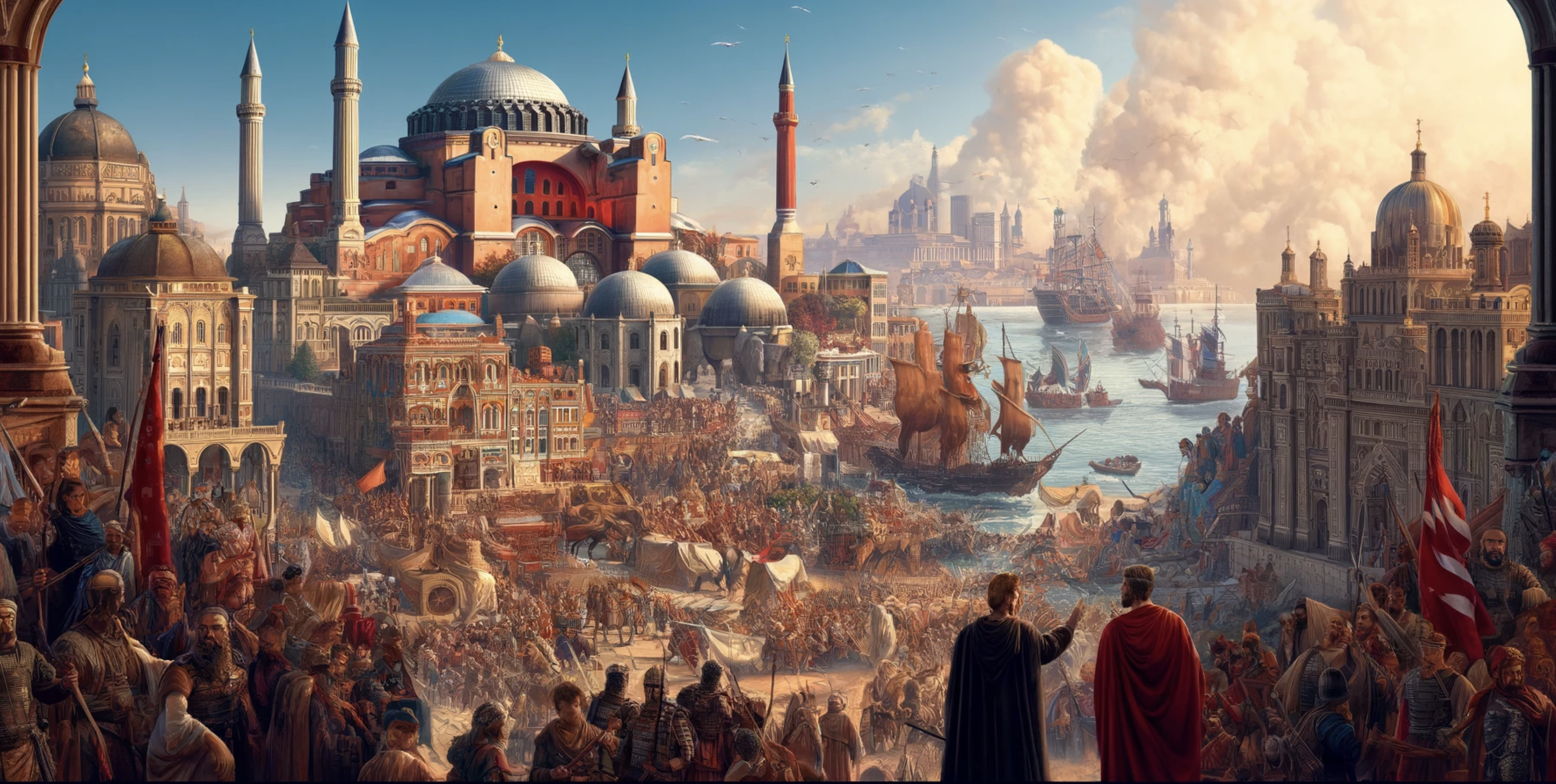
In the early 7th century, the Byzantine Empire was in turmoil, facing multiple challenges from both within and outside its borders. Emperor Heraclius (610-641 CE) played a pivotal role in recovering territories that had been lost to the Sassanian Persians, including the significant city of Jerusalem. However, the subsequent Arab conquests under the Umayyad Caliphs resulted in the loss of vast territories, including Syria, Palestine, Egypt, and North Africa.
Dynastic Changes
The Byzantine Empire underwent significant dynastic changes, particularly with the rise of the Macedonian Dynasty (867-1056 CE), which began with Basil I. This period marked a consolidation of the empire’s power and territorial integrity. Basil II (976-1025 CE), famously known as the “Bulgar Slayer,” further expanded the empire by annexing Bulgaria in 1018. During this era, the Byzantine Empire enjoyed a relatively stable economy, lucrative trade across Eurasia, and flourishing art and architecture.
Byzantine Christianity
The Byzantine Empire was a stronghold of Orthodox Christianity, but it experienced significant religious conflicts and transformations:
- Iconoclasm: The first period of Iconoclasm (726-787 CE) was initiated by Emperor Leo III, who banned the veneration of icons, leading to internal religious conflict. This policy was briefly reversed but was revived during the Second Iconoclasm (814-842 CE) under Emperor Leo V. The practice was permanently ended by Empress Theodora in 842 CE, restoring the veneration of icons within the church.
- Great Schism (1054): Theological and political disputes between the Byzantine Empire and the Roman Catholic Church culminated in the Great Schism of 1054. This schism sowed the seeds for the eventual permanent division between the Eastern Orthodox and Roman Catholic Churches, marking a significant turning point in Christian history.
Political and Military Resilience
The Byzantine Empire demonstrated remarkable political and military resilience, managing to survive numerous threats from both external and internal forces. The theme system, reorganizing military and civilian administration, allowed for a more efficient and flexible military response to invasions, contributing to the empire’s longevity.
Cultural and Religious Influence
The construction of the Hagia Sophia under Justinian I epitomized the architectural and cultural achievements of the empire, symbolizing the spiritual and artistic heights of Byzantine civilization. The spread of Orthodox Christianity to the Slavic peoples through the missions of Saints Cyril and Methodius further extended Byzantine cultural influence, particularly with the development of the Cyrillic alphabet.
Economic and Technological Innovations
The Byzantine economy, benefiting from its strategic location, was one of the most advanced in the medieval world. Constantinople, the empire’s capital, was a thriving hub of commerce and trade. The city’s markets were renowned for their diversity of goods. Technological innovations, such as the secret of silk production and advancements in military technology like Greek fire, marked this period.
Legal and Administrative Reforms
The Codex Justinianus, or Justinian Code, compiled under Emperor Justinian I, systematically codified Roman law and influenced legal systems in both the Eastern and Western worlds. The Byzantine administrative system, particularly the theme system, enhanced military efficiency and integrated civilian governance, contributing to the stability and resilience of the empire.
Western Christendom
Recap of March 2023
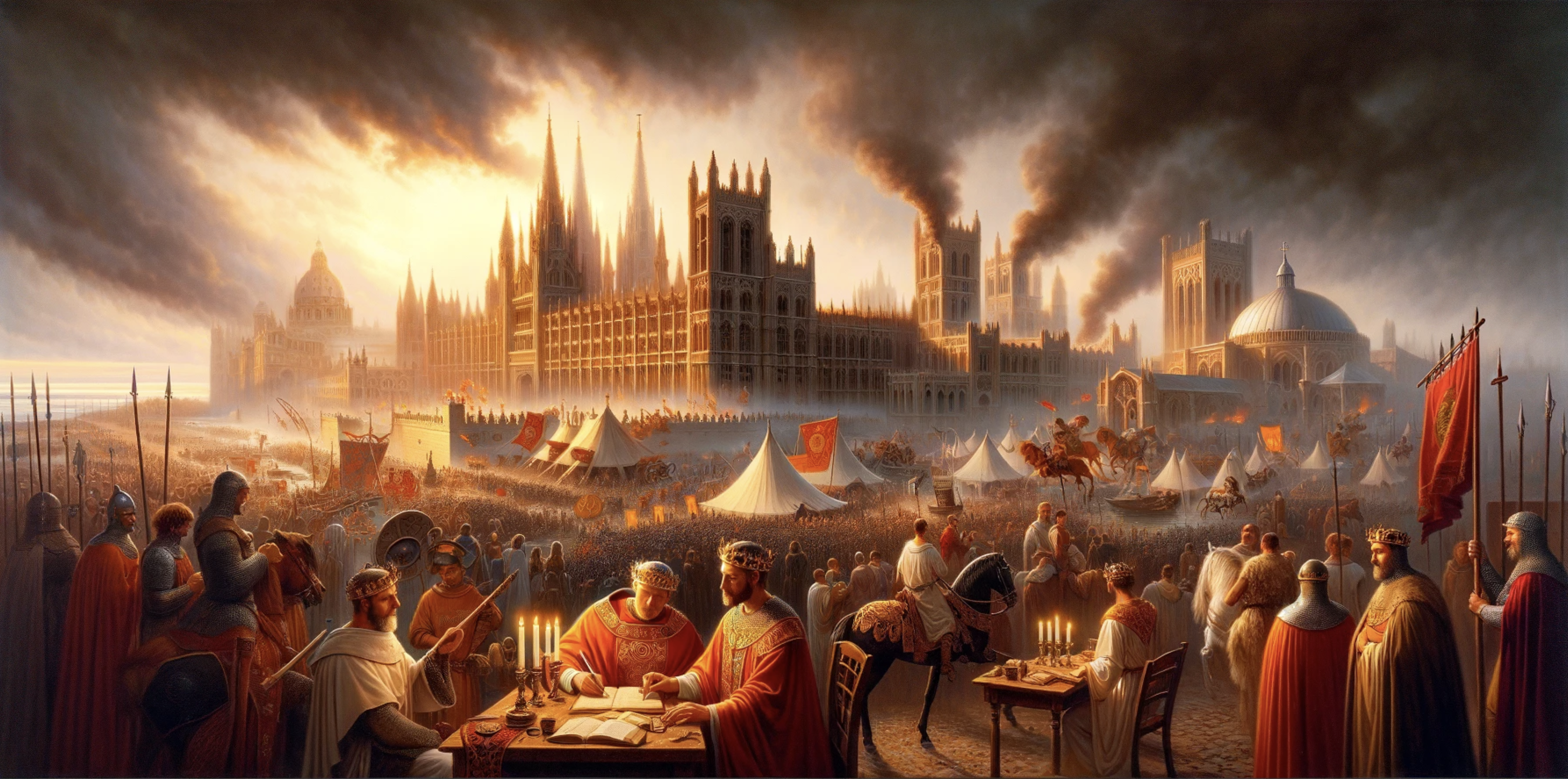
In March 2023, we explored the roots of modern science, focusing on four key movements:
- Scholasticism: This philosophical and theological system sought to reconcile faith with reason, blending Christian doctrine with classical philosophy.
- Islamic Science: The preservation and advancement of knowledge in the Islamic world greatly influenced Western thought.
- Renaissance Humanism: This movement emphasized the value of human beings and the study of classical texts, fostering a revival in art, literature, and science.
- Protestant Reformation: Initiated by figures like Martin Luther, it led to significant religious, political, and social changes in Europe.
We also discussed two significant contributors to Western thought:
- Roger Bacon: An early advocate of the scientific method.
- Thomas Aquinas: Integrated Aristotelian philosophy with Christian theology.
The session also covered the Copernican Revolution, spearheaded by Nicolaus Copernicus, who proposed a heliocentric model of the universe.
Charlemagne and the Holy Roman Empire
Charlemagne’s crowning by Pope Leo III in 800 AD marked the revival of the Western Roman Empire, laying the foundation for the Holy Roman Empire. His reign was characterized by:
- Expansion and Administration: Charlemagne expanded his empire through military campaigns and implemented a system of administration through counts, supported by a network of royal agents known as missi dominici.
- Cultural Renaissance: The establishment of the palace school in Aachen and the creation of illuminated manuscripts marked the Carolingian Renaissance.
- Legal and Religious Reforms: Charlemagne codified laws, integrating Roman law with Germanic customs, and supported the spread of Christianity.
The Vikings
Starting in the 8th century, Viking raids and settlements had a profound impact on Europe. They settled in Britain, Normandy, and parts of Eastern Europe, establishing extensive trade networks that connected Europe to the Middle East, Central Asia, and even North America (Vinland). The Norse legacy is evident in the language, art, and technology of the regions they settled. Viking slaving activities were significant, with slaves captured and traded across Europe and the Islamic world.
Spread of Western Christendom
- Missionary Efforts: Figures like St. Boniface in Germany and St. Patrick in Ireland played crucial roles in converting pagan populations to Christianity.
- Monasticism: Monasteries throughout Europe became centres of learning, agriculture, and cultural preservation.
- Political Alliances: Rulers sought the support of the church, strengthening their own power and influence.
Crusades
From the late 11th century, the Crusades aimed to reclaim the Holy Land from Muslim control and strengthen and spread Christianity.
Influence of the Church Throughout Europe
Joseph Henrich has identified a series of linked policies imposed by the church and conforming states, known as the “Marriage and Families Programme,” which started in the era of Constantine and continue to the present day. These policies included:
- Marriage Laws: The church imposed strict regulations on marriage, banning polygamy, concubinage, and consanguinity to create nuclear families.
- Monogamy and Fidelity: The church promoted monogamous and indissoluble marriages to foster social order and moral behaviour.
- Inheritance and Property: Property passed down within nuclear families, preventing the fragmentation of estates and supporting economic stability.
- Clerical Influence: The church extended its influence into the daily lives of laypeople, strengthening its social and moral authority.
Social and Psychological Consequences
These policies had profound effects on societal structures and individual behaviour. Socially, they led to weaker ties to land and extensive kin, greater mobility, and increased dependence on the church. Psychologically, they fostered greater individualism, analytical thinking, and a shift from shame to guilt, resulting in lower normative conformity, less impatience, and reduced risk-seeking behaviour.
Over time, Henrich argues, these changes contributed to the development of representative governments, individual-centred law, Protestantism, innovation, and economic growth.
Terry Cooke-Davies
7th June 2024
With thanks to ChatGPT(4o) for support and co-operation in the preparation of this blog post.
